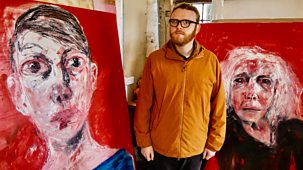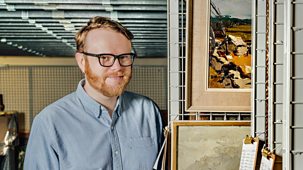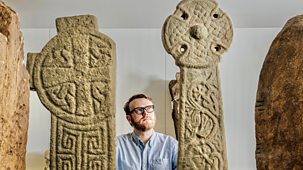
Series 1: Episode 3
In this final episode, Huw Stephens’s journey begins at the dawn of the 20th century with the artists who broke with tradition and depicted Wales in radical new ways. In Snowdonia, he learns how Augustus John and JD Innes led the way, obsessively painting the landscape with a freedom and vibrancy that still dazzles today. Equally bold was the work of Gwen John, whose work is in complete contrast to that of her brother Augustus. At the National Museum Wales in Cardiff, Huw discovers how she used light and tone to paint delicate and hypnotic portraits and interior scenes.\n\nBetween the wars, industrial south Wales produced some of the most powerful art of the century. Huw discovers how the work of Evan Walters and Cedric Morris is steeped in their experience of mining communities and the desperate poverty they endured. The lives of striking miners were rarely reflected in art, but Walters’s 1926 portrait of his friend William Hopkins captured his subject with dignity and honesty.\n\nTravelling north, Huw heads out to Bardsey Island off the Llyn Peninsula, a place he first visited as a teenager. The landscape of Wales has long been a source of inspiration for artists and in the 1940s Brenda Chamberlain moved to Bardsey to immerse herself in its isolation. Inside the picturesque cottage where she lived, Huw sees her sketches of island life that she drew on the walls ‘as if they were a giant sketchbook’. At the same time, Kyffin Williams was painting the distinctive, dramatic landscapes of north Wales, establishing himself as the most popular Welsh artist of the 20th century. \n\nContemporary art in Wales reflects a post-devolution self-confidence that allows it to look both back and forward. In Swansea, Huw meets Daniel Trivedy and learns how his award-winning work Welsh Emergency Blanket took the patterns of traditional Welsh blankets and printed them on to the silver foil coverings given to refugees rescued from the sea. For his final stop, Huw visits Colwyn Bay where he meets internationally renowned artist Bedwyr Williams, whose work draws heavily on Welsh art history using humour and irreverence. It is a unique history, Bedwyr concludes, and one that makes him excited to be living and working in north Wales.
Source: BBC 4
Most recent episodes of The Story of Welsh Art
The Story Of Welsh Art
Series 1: Episode 3
In this final episode, Huw Stephens’s journey begins at the dawn of the 20th century with the artists who broke with tradition and depicted Wales in radical new ways. In S ...
18-03-2024
BBC 4
The Story Of Welsh Art
Series 1: Episode 2
Scrambling up the side of one of Wales's highest and most rugged mountains, Huw Stephens retraces the steps of Richard Wilson, an 18th-century artist who changed the course of a ...
11-03-2024
BBC 4
The Story Of Welsh Art
Series 1: Episode 1
Huw Stephens explores what has long been a missing piece in the cultural story of Britain and indeed Wales itself – the story of Welsh art.\n\nHuw starts his journey on th ...
04-03-2024
BBC 4
Most popular episodes of The Story of Welsh Art
The Story Of Welsh Art
Series 1: Episode 1
Huw Stephens explores what has long been a missing piece in the cultural story of Britain and indeed Wales itself – the story of Welsh art.\n\nHuw starts his journey on th ...
04-03-2024
BBC 4
The Story Of Welsh Art
Series 1: Episode 3
In this final episode, Huw Stephens’s journey begins at the dawn of the 20th century with the artists who broke with tradition and depicted Wales in radical new ways. In S ...
18-03-2024
BBC 4
The Story Of Welsh Art
Series 1: Episode 2
Scrambling up the side of one of Wales's highest and most rugged mountains, Huw Stephens retraces the steps of Richard Wilson, an 18th-century artist who changed the course of a ...
11-03-2024
BBC 4



